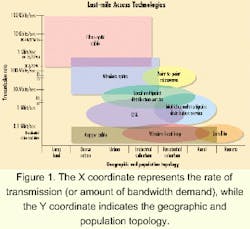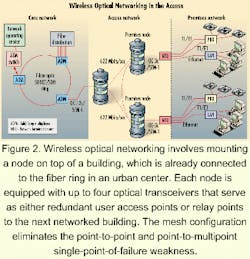The upcoming year in wireless optics
A suite of broadband technologies such as wireless optics, WDM, RF wireless, and fixed wireline will offer the most cost-effective solution for each segment of the business market.
Janet McVeigh
AirFiber
For many years, telephone lines were the narrowband solution that served the average user's needs. This is changing. Driven by deregulation in the telecommunications industry and rapid Internet growth, business and residential customers need increasing amounts of capacity to accommodate a new generation of bandwidth-intensive voice, video, data, and Internet applications (see Table).
Concurrent with this growth in bandwidth demand, communications networks have benefited from dramatic technology advances in the core and premises portions of the infrastructure. Core network technology has evolved from OC-12 (622 Mbits/sec) to OC-48 (2.5 Gbits/sec), OC-192 (10 Gbits/sec), and DWDM-with steep declines in the cost per bit. Similarly, premises-network technology has advanced from 10 Mbits/sec and 100 Mbits/sec to 1 Gbit/sec and even 10-Gigabit Ethernet, with dramatic drops in the cost per bit.
Despite these technology advances, the portion of the network connecting the core and the premises networks-the access infrastructure, also known as the last mile or the first mile-is behind the technology curve and viewed as a network bottleneck. Advances in free-space optics, however, have made this technology a high-bandwidth access solution, especially when it is integrated with other last-mile technologies.
Carriers are deploying different types of access technologies all over the world to address the last-mile bottleneck-DSL; cable; fiber; multichannel multipoint distribution service (MMDS); and local multipoint distribution service (LMDS), among others. Many carriers have based an entire business plan on just one of these types of technologies. There is not a one-size-fits-all answer to the last-mile question. Specific characteristics of the technologies may make one technology better suited than another to address different aspects of the market.
Figure 1 shows the optimal last-mile technology solutions based on end-user demand and geographic/population topology. The relative positioning of the last-mile technologies was derived from technological capabilities such as reach, bandwidth, reliability, and the economics of the technology in that particular application.Copper lines, for instance, are widespread-readily available in dense urban regions all the way through rural areas-with more than 700 million lines deployed worldwide. Copper wires, however, are extremely slow compared to other technologies and are owned mostly by incumbent local-exchange carriers. Although DSL-"turbocharged" copper lines-utilizes the existing wireline infrastructure, copper wires were never intended to provide high-speed data. Upgrading the lines is expensive, and even then maximum data rates are severely limited. Additionally, the availability of DSL is limited to distances of about 20,000 ft from the carrier's central office. Copper, utilizing DSL, is a good solution for end users looking for an inexpensive connection at capacities of about 1.5 Mbits/sec.
On the other end of the spectrum, there is fiber, the highest-capacity and most reliable access technology. Fiber is capable of speeds in excess of 10 Gbits/sec, but the downside is that it's extremely expensive compared to other access technologies. Less than 5% of U.S. commercial buildings and less than 1% of buildings worldwide are directly connected to fiber-optic networks because of the high cost of fiber optics. Fiber installation in a building can cost anywhere from $100,000 to $250,000. The installation can take months, or even up to two years given the distance to a carrier's (or leaser's) fiber/SONET ring and ability to negotiate rights-of-way. The capacity and costs associated with fiber and its installation prevent it from being a ubiquitous technology. In most cases, fiber is installed in large urban buildings where there is a demand of several OC-3s or more. (Of course, fiber is the ideal technology for metropolitan backbone and intercity long-haul networks.)
In between fiber and copper, there are many different types of wireless technologies, all of which avoid landline wire connections by transmitting over the air.
LMDS is a broadband wireless point-to-multipoint communication system. It allows carriers to provide a vast array of one-way and two-way telecommunications services. This technology has many advantages, primarily on a point-to-multipoint basis where multiple T-1 speeds are common. More recent advances in point-to-multipoint technology offer service providers a way to supply high-capacity local access that is less capital-intensive than a wireline solution, is faster to deploy than wireline, and supports a range of applications.But to utilize an LMDS system, carriers must first acquire costly spectrum licenses. The spectrum available is limited, and it must be managed to avoid interference. Coverage depends on the location of hub sites and line-of-site from the hub to customers, decreasing the number of customers that can be served from a given hub. Services are affected by inclement weather-primarily rain-that can decrease the distance the signal can reliably travel. The most likely market segment for LMDS is the medium-sized business market, which currently requires multiple T-1 lines (1.54 Mbits/sec)-perfect for filling the "bandwidth gap" for users requiring 1.5- to 10-Mbit/sec data rates, the range used by many small and medium businesses.
MMDS, the original provider of wireless cable TV, has evolved into a potential competitor of providers of multichannel video and video-on-demand products. MMDS providers, making the most efficient use of a small amount of frequencies, have also emerged as potential suppliers of many broadband services. Deployed in a point-to-multipoint topology, MMDS systems can provide a maximum of 10-Mbit/sec speeds per customer, but T-1 speeds and below are more common. MMDS signals have more expansive coverage than LMDS, taking advantage of extensive line-of-sight in all directions and carrying the signal 30 to 35 miles from the transmitter. However, MMDS operators, like those utilizing LMDS, must also acquire spectrum licenses.
More than 10 years ago, technological advances made it possible to transmit high bandwidth over the air between two points using free-space optics or invisible beams of light instead of radio spectrum. Transmitted through free space (i.e., air), free-space optics affords fiber-like speeds (typically OC-3 to OC-12) without the fiber. Spectrum licenses were not required for this kind of transmission, since interference between devices is not a concern.
But early free-space optics technology was not reliable enough for carriers to adopt as a last-mile solution. Free-space laser signals were lost during inclement weather (primarily fog) and building movement due to solar and wind loading, decreasing the system's reliability. Furthermore, free-space optics designed for point-to-point connectivity suffered from a single point of failure over the air, diminishing reliability. Carriers were unwilling to deploy such systems as a last-mile solution for their customers without higher reliability and network scalability.
In the past couple of years, however, the combination of free-space optics, networking technology, and refinements to the optical links has enabled carrier-grade wireless optical-networking technology. The best example of this improvement is the replacement of the point-to-point links with a wireless mesh network providing 99.999% (five-nines) carrier-class availability, which consists of multiple optical links. These wireless optical mesh networks enable fiber extension from the backbone network directly into buildings. This wireless optical technology offers very-high-bandwidth (OC-3 and up) capabilities economically. Utilizing a redundant mesh architecture, short links, and automatic tracking technology enhances the technology's reliability.Wireless optical networking involves mounting a node on top of a building, which is already connected to the fiber ring in an urban center. Eye-safe near-infrared optical links transmit high-bandwidth voice, data, and multimedia services from that node to nodes on nearby buildings (see Figure 2). Each node is equipped with up to four optical transceivers that serve as either redundant user access points or relay points to the next networked building. The mesh configuration eliminates the point-to-point and point-to-multipoint single-point-of-failure weakness via multiple paths into a building, providing for alternate path rerouting around failures. If a link is disrupted or if there is equipment failure, the signal is rerouted via another path in the mesh so that service is not disrupted.
High-bandwidth wireless optical networks deployed in an urban area connect buildings with fiber-like speeds for about one-fifth the cost of installing fiber-in a matter of days rather than months or years. But link distances of around 200 to 500 m are required to maintain five-nines reliability.
Many technologies are at work to solve the last-mile bottleneck. Carriers focused on quality of service-as well as the bottom line-will select technologies on the basis of market realities. Such considerations include technical aspects (transmission rates, reach and coverage desired, state of deployment, business vs. residential availability, etc.), economic realities (geographic location such as urban or remote environment), and individual market needs (bandwidth requirements and services desired). These market-segment differences suggest that a hybrid last-mile strategy, incorporating a combination of broadband wireless with other fixed wireline options (such as fiber optics) will offer the most cost-effective and reliable solution for each segment of the business market.
For instance, a typical city consists of a downtown dense urban core of mass-populated buildings in close location to each other, an urban area surrounding it with less densely populated buildings, an industrial suburban area (typically containing campus environments), and a residential suburban area. Deploying one type of technology to all of these areas makes little sense.
Fiber connections to the very largest buildings with capacity demands in excess of 622 Mbits/sec (OC-12) justify the high costs of installing fiber. Wireless optics will be used to connect the remaining buildings in the downtown urban core and larger business campuses, satisfying demands of around 5 to 622 Mbits/sec. Buildings in the outlying urban areas (not within the five-nines threshold afforded by wireless optics) with demand levels between a single T-1 line (1.5 Mbits/sec) to several T-1s will benefit from LMDS. The residential areas will take advantage of either DSL or MMDS technologies.
In the next year, more companies will deploy a suite of access technologies. The Internet has evolved into a critical business tool, its usage growing dramatically in the last five years. To accommodate this explosive growth, it is critical that businesses get high-speed broadband access to support these media-rich, memory-intensive applications. The combination of free-space optical technology and other last-mile networking technologies can provide companies with the required high-bandwidth access solutions.
Janet McVeigh is vice president of marketing for AirFiber Inc. (San Diego). The company's Website is www.airfiber.com.



